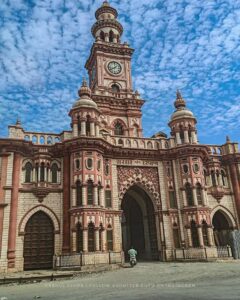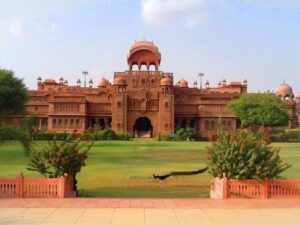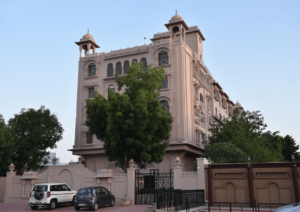Bikaner, a city in the Indian state of Rajasthan, is steeped in history and royal heritage. It holds a significant place in the annals of Indian history, known for its fearless kings, opulent palaces, and majestic forts. Bikaner’s rich cultural tapestry and architectural splendor make it a captivating destination for history buffs and travelers.
The city’s royal heritage is evident in its splendid forts and palaces, which testify to its glorious past. These architectural marvels stand as reminders of the grandeur and magnificence of the Rajput rulers who once reigned over the region.
1. Junagarh Fort
Junagarh Fort, one of the most imposing structures in Bikaner, boasts a rich history that dates back to the 16th century. Raja Rai Singh, a trusted general in the Mughal emperor Akbar’s army, built it. Construction of the fort commenced in 1589 and continued over the years, with subsequent rulers adding their contributions to its grandeur.
The architectural design of Junagarh Fort is a splendid fusion of Rajput and Mughal styles, reflecting the diverse influences prevalent during its construction. The fort is characterized by its massive walls, intricately carved facades, and ornate gateways adorned with exquisite artwork and motifs.
Visitors can explore several remarkable sections that offer glimpses into Bikaner’s royal legacy within the sprawling expanse of Junagarh Fort. Anup Mahal, with its elaborate mirror work and frescoes, is a testament to the luxury of the erstwhile rulers. Ganga Niwas and Chandra Mahal, adorned with intricate carvings and delicate paintings, showcase the refined craftsmanship of the artisans of yore.
Exploring Junagarh Fort is a fascinating journey through time, offering insights into the grandeur and splendor of Rajasthan’s royal past. Visitors can immerse themselves in the history and heritage of the fort through guided tours, which provide in-depth knowledge about its architecture, history, and cultural significance. The fort is open to visitors throughout the year, with timings allowing ample time for exploration and appreciation of its treasures.
2. Laxmi Niwas Palace
Laxmi Niwas palace, another gem in Bikaner’s crown, is prominent in the city’s royal heritage. Built-in the early 20th century by Maharaja Ganga Singh of Bikaner, the palace served as a symbol of his opulence and grandeur. Its construction departed from traditional Rajput architecture, embracing the Indo-Saracenic style that was popular during the colonial era.
The architectural splendor of Laxmi Niwas palace is a sight to behold. Characterized by its grand domes, intricate carvings, and sprawling courtyards, the palace exudes an aura of regal elegance. Its interiors are adorned with ornate furnishings, magnificent chandeliers, and exquisite artwork, reflecting the lavish lifestyle of the erstwhile rulers.
In recent years, Laxmi Niwas Palace has been transformed into a luxury heritage hotel, offering guests a glimpse into the opulent lifestyle of Bikaner’s royalty. The palace has been meticulously restored to its former glory, providing guests with an unforgettable experience steeped in history and luxury. Visitors can immerse themselves in the palace’s grandeur while enjoying modern amenities and world-class hospitality.
Visiting Laxmi Niwas palace offers travelers a unique opportunity to immerse themselves in Bikaner’s royal past splendor. Guided tours of the palace provide insights into its history, architecture, and cultural significance, allowing visitors to appreciate its beauty and craftsmanship up close. The palace also offers luxurious accommodations, ensuring a memorable stay amidst the regal surroundings.
3. Junagarh Fort Museum
Located within the sprawling complex of Junagarh Fort lies a treasure trove of history and culture—the Junagarh Fort Museum. This museum serves as a repository of Bikaner’s rich heritage, housing a fascinating collection of artifacts, artworks, and historical relics that offer insights into the city’s glorious past.
The Junagarh Fort Museum boasts an impressive array of exhibits spanning various periods of Bikaner’s history. Visitors can marvel at ancient weapons, intricate paintings, royal costumes, and exquisite jewelry, each providing a glimpse into the lives and traditions of Bikaner’s erstwhile rulers. The museum’s collection offers a comprehensive overview of the region’s cultural heritage, showcasing the diverse influences shaping Bikaner’s identity over the centuries.
Exploring the exhibits at Junagarh Fort Museum offers visitors a deeper understanding of Bikaner’s cultural heritage. From the vibrant colors of Rajasthani folk art to the intricate craftsmanship of royal artifacts, each display provides valuable insights into the customs, traditions, and lifestyles of the people who once inhabited the region. Through interactive exhibits and informative displays, visitors can immerse themselves in the rich tapestry of Bikaner’s cultural heritage, gaining a newfound appreciation for its historical significance.
Junagarh Fort Museum welcomes visitors throughout the year, offering an enriching experience for history enthusiasts and cultural aficionados alike. The museum’s opening hours and ticket prices are designed to accommodate visitors of all ages, ensuring accessibility for locals and tourists. Guided tours are available for those seeking a more immersive experience, providing valuable insights into the museum’s exhibits and historical significance.
4. Gajner Palace
Gajner Palace, situated on the banks of the picturesque Gajner Lake, holds a storied past steeped in royal splendor. Built by Maharaja Ganga Singh of Bikaner in the late 19th century, the palace served as a royal hunting lodge and retreat for the erstwhile rulers of Bikaner. Its strategic location amidst the tranquil surroundings of the Gajner Wildlife Sanctuary made it a favored destination for leisure and relaxation.
The architecture of Gajner Palace is a testament to the grandeur and elegance of Rajasthan’s royal heritage. Constructed in red sandstone, the palace features intricately carved facades, majestic domes, and sprawling courtyards that reflect the architectural style prevalent during the Rajput era. Its serene surroundings and panoramic views of the surrounding landscape make it a haven of tranquility and natural beauty.
Adjacent to Gajner Palace lies the sprawling expanse of the Gajner Wildlife Sanctuary, home to a diverse array of flora and fauna. Spread across the sandy plains of Bikaner, the sanctuary provides a sanctuary for migratory birds, including cranes, ducks, and pelicans, making it a paradise for birdwatchers and nature enthusiasts. Visitors to Gajner Palace can explore the sanctuary and go on wildlife safaris to witness the region’s rich biodiversity up close.
Gajner Palace offers visitors a range of facilities and amenities to ensure a comfortable and memorable stay. Guests can choose from luxurious accommodation options, including well-appointed suites and heritage rooms, each designed to evoke the opulence and grandeur of Rajasthan’s royal era. The palace also features exquisite dining venues serving authentic Rajasthani cuisine, allowing guests to savor the region’s flavors in a regal setting.
Tips to Visit Bikaner
Visiting Bikaner’s forts and palaces is an enriching and immersive experience, offering insights into the region’s rich cultural heritage and royal legacy. By following these practical tips, travelers can make the most of their journey, ensuring a memorable and fulfilling exploration of Bikaner’s magnificent attractions.
Getting There
Traveling to Bikaner is convenient via various modes of transportation. The city is well-connected by road, rail, and air. Visitors can opt for train services or book private taxis from nearby cities like Jaipur and Jodhpur. The nearest airport, Nal Airport, offers limited flight options, with Jaipur International Airport serving as the primary gateway for air travelers.
Best Time to Visit Bikaner
Bikaner experiences extreme weather conditions, with scorching summers and chilly winters. The best time to visit is during the winter, from October to March when the weather is pleasant and conducive to sightseeing and outdoor activities. Avoid visiting during the peak summer months, from April to June, when temperatures soar, making outdoor exploration uncomfortable.
Cultural Etiquettes of Bikaner
Respect for local customs and traditions is paramount when visiting Bikaner’s forts and palaces. Dress modestly and conservatively, especially when visiting religious sites and heritage monuments. Remove footwear before entering temples and other sacred spaces, and avoid touching or defacing historical artifacts and structures. Photography may be restricted in certain areas, so always seek permission before taking pictures.
Chandra Mahal – Best Heritage Hotel in Bikaner
Chandra Mahal is a beacon of luxury and heritage in Bikaner. Guests can immerse themselves in the regal ambiance of Chandra Mahal, where opulent suites, elegant furnishings, and personalized service evoke the splendor of Rajasthan’s royal era. Each room is adorned with amazing artwork, intricate carvings, and modern amenities, ensuring a comfortable and memorable stay for travelers.
Souvenir Shopping in Bikaner
Bikaner is renowned for its vibrant markets and bustling bazaars, offering a plethora of souvenirs and handicrafts for visitors to take home. Explore the narrow lanes of the old city to discover traditional Rajasthani artifacts, embroidered textiles, camel leather goods, and intricate metalwork. Bargaining is common in local markets, so don’t hesitate to negotiate prices to secure the best deals.
Exploring Bikaner’s forts and palaces is an immersive experience that allows visitors to connect with the soul of Rajasthan. Amidst the labyrinthine corridors and echoing chambers, one can feel the echoes of a bygone era where kings and queens ruled with grace and grandeur.
Moreover, the city’s vibrant markets, bustling streets, and colorful festivals offer a glimpse into the everyday life of its inhabitants, whose warmth and hospitality welcome travelers with open arms.





